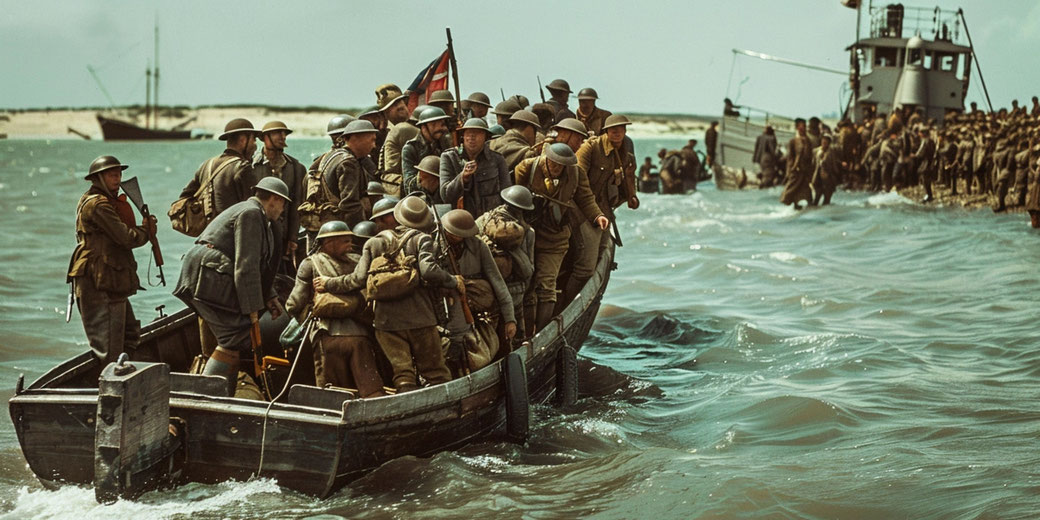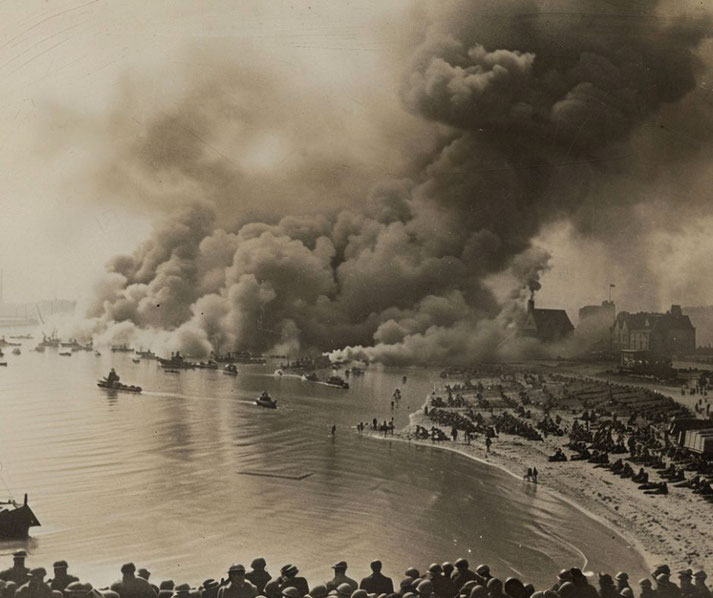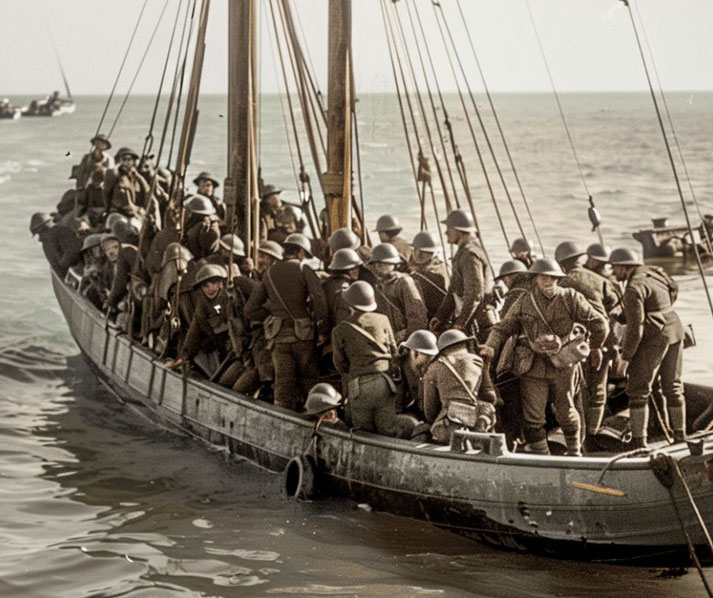What were the Little Ships of Dunkirk?

In the dark days of May 1940, an extraordinary fleet of civilian vessels set sail for Dunkirk, France. These 'Little Ships', as they came to be known, embarked on a precarious mission to rescue hundreds of thousands Allied soldiers from certain doom on the beaches of Europe.
Under constant threat from enemy attack themselves, these small boats braved treacherous waters to ferry stranded troops to safety.
This is the story of the people and vessels that made up this remarkable event during WWII.
Why thousands of soldiers were trapped
In the spring of 1940, during the early stages of World War II, the German military launched a blitzkrieg, or 'lightning war', into Western Europe.
It took everyone off-guard when it was begun on May 10, 1940. The German forces invaded Belgium, the Netherlands, and Luxembourg, quickly bypassing the heavily fortified Maginot Line along the French border.
This fast-moving assault led to the rapid collapse of the Allied defenses in Belgium and France.
By May 21st, the German panzer divisions had reached the English Channel.
This effectively cut off the British Expeditionary Force (BEF) and several French and Belgian units from the main Allied forces.

How Britain aimed to save their men
The Allied troops found themselves surrounded, with their backs to the sea near the port town of Dunkirk.
With German forces rapidly closing in, the situation was indeed dire, and the likelihood of survival seemed increasingly slim.
In this bleak situation, the British government and military leaders realized that a massive evacuation was necessary to save the trapped soldiers.
As a result, they created Operation Dynamo, which was hastily organized and put into action on May 26, 1940.
This evacuation plan sought to transport the men from the beaches, via large navy vessels, and sail them back to Britain to safety.
However, there was a significant problem: the beaches of Dunkirk were not suitable for large ships to dock.
Such massive navy vessels were required to shift the large numbers of men.
But there was no way for those ships to reach the shore.
Additionally, the harbor at Dunkirk was partially blocked and under constant attack.
If the larger vessels did attempt to dock, they would be sitting ducks for the Luftwaffe.
The desperate call for civilian help
The British government came up with an innovative solution: ask for as many people as possible to volunteer the use of their personal boats to help out.
The smaller vessels could act as ferries, sailing between the shoreline of the beaches, out to the navy ships.
The more boats of this nature that they could access, the more men could be saved from annihilation.
So, the call for assistance went out on May 29, 1940, and hundreds of boat owners responded.
What was amazing about this was that these people were willing to risk their own lives to aid in the rescue mission.
This extraordinary mobilization provided the British navy with a diverse flotilla of civilian vessels: just what they needed.
It included fishing boats, pleasure craft, yachts, lifeboats, and other small craft.
However, since they were departing from various ports along the English coast, these vessels had to make their own way across waters of the English Channel.
Just like the bigger navy vessels, they faced threat of aerial attacks from the Luftwaffe.
How the evacuation was carried out
The British navy tried to make the evacuation process during Operation Dynamo as efficient as possible.
To this end, the beaches of Dunkirk were divided into sectors. Royal Navy officers and military personnel on the ground were meant to coordinate the orderly loading of troops onto the waiting vessels.
To their credit, the soldiers, many of whom had been under constant bombardment and had endured long marches to reach the coast, were able to form queues stretching down the beaches and into the water.
Once the Little Ships arrived at the French coast, the shallow waters and sandbanks near Dunkirk made their task particularly difficult.
Moreover, there was widespread destruction in and around the harbor, with sunken vessels and debris scattered everywhere.
It was made even more challenging by the fact that the congestion of boats and the smoke from burning oil tanks, obscured their visibility.
Upon reaching the beaches though, the soldiers had to be quickly taken on board; but most of the small vessels were not designed for such operations.
They did not have proper gangways or loading equipment. In some cases, soldiers had to wade out to the boats themselves.
To help out, some of the nimbler boats navigated directly to the beaches, where soldiers clambered aboard from the water or from makeshift jetties constructed from abandoned vehicles and other debris.
Regardless of the method used to get the men onboard, the smaller vessels then shuttled groups of soldiers out to the larger ships anchored offshore.

The triumphs and tragedies of the operation
Across the difficult days of the evacuations, a thousand stories of heroism and selfishness took place that were never recorded.
However, a few notable events later came to light. For example, the paddle steamer Medway Queen, made seven trips to Dunkirk, rescuing 7,000 men.
In addition, the fishing boat Tamzine, the smallest boat in the evacuation, at just 14 feet in length, worked tirelessly to help out as much as it could.
It was used to rescue an untold number of men.
No matter how small it was, it took on board grateful soldiers who had been queuing for hours, or even days, under constant bombardment from the Luftwaffe.
Unfortunately, there were many terrible losses as well. One such example was the crew of the destroyer HMS Basilisk, which, despite being severely damaged by German bombs, managed to rescue hundreds of soldiers before being abandoned.
The Royal Air Force tried desperately to provide cover to protect the vessels from air attacks.
Their efforts no doubt prevented many more losses like this.
The unbelievable result
The contribution of the Little Ships in the evacuation was truly remarkable. An estimated 30% of all the evacuated troops were carried aboard these vessels.
As a result, Operation Dynamo enabled the successful evacuation of over 338,000 Allied troops.
This included approximately 198,000 British and 140,000 French and Belgian soldiers.
Ultimately, the preservation of these forces was crucial for the Allies. It maintained the core of the British Army and provided a foundation for future military efforts against Nazi Germany.
The enormous efforts of these civilian boats were promoted as a sign of hope and solidarity among the British population.
Their bravery and selflessness embodied the "Dunkirk spirit" of determination and resilience.
Without the voluntary contribution of hundreds of regular British civilians, the greatest naval evacuation in human history would never have occurred.
What do you need help with?
Download ready-to-use digital learning resources
Copyright © History Skills 2014-2024.
Contact via email
With the exception of links to external sites, some historical sources and extracts from specific publications, all content on this website is copyrighted by History Skills. This content may not be copied, republished or redistributed without written permission from the website creator. Please use the Contact page to obtain relevant permission.





